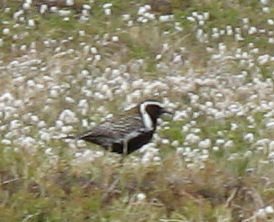Blooming Tundra

Spring arrived a few weeks later than usual this year, but is moving in quickly to catch up. Snow and ice is mostly gone now, except for a few deep gullys that never see direct sunlight. And the Alaskan tundra is starting to bloom in the nearly around-the-clock daylight.
There is a huge variety of grasses, moses, lichen, and flowering plants. Cotton grass is everywhere, putting out little puffs of white that look like close cousins to the king plant of the Deep South. It looks like a carpet of white across the tundra, and Eskimo legend says that the amount of cotton grass in the summer predicts the next winter's snowfall. Small pink flowers add spots of color, and deep within the spongy ground cover are tiny little blooms on the blueberry and blackberry plants that will develop into tart and tasty berries by August. It is hard to fathom how this riot of growth can survive the severe cold of winter, but somehow it does. The earth laughs in flowers, and nowhere more so than during the brief growing season here on the subarctic tundra.

One of our most colorful flowers is fireweed. It grows along the roadsides and anywhere the tundra's protective cover has been peeled aside by big machines. It is a true chronometer of summer's progression; the two-foot stalks begin blooming at the base around the time of summer solstice, and by the time the top of the stalk has flowers, summer is about over. This photo was taken in July.
 Along with the flowers, my week was gladdened by the return of a pair of Lesser Golden Plover (Pluvialis dominica) who nested successfully on the tundra right in front of our house last summer. They stayed for about six weeks and raised two offspring before departing for their winter home in South America. What an incredible distance to fly! They are rather small birds, only a little larger than robins. The two that nested in our "yard" were the only two I saw anywhere, and I was surprised and delighted to find that they had returned (of course I want to believe that it is the same pair). This morning I managed to sneak close enough to the male to snap this photo of him standing in a large patch of cotton grass; I need a better telephoto lens to capture the details of his beauty. He is very "flighty", and takes wing at the slightest movement in his surroundings. His mate has very similar coloring, with less black on the breast and underbody. They take turns tending the nest diligently. I wonder if their youngsters from last year returned with them, but so far have seen only the two. I hope they do as well this year.
Along with the flowers, my week was gladdened by the return of a pair of Lesser Golden Plover (Pluvialis dominica) who nested successfully on the tundra right in front of our house last summer. They stayed for about six weeks and raised two offspring before departing for their winter home in South America. What an incredible distance to fly! They are rather small birds, only a little larger than robins. The two that nested in our "yard" were the only two I saw anywhere, and I was surprised and delighted to find that they had returned (of course I want to believe that it is the same pair). This morning I managed to sneak close enough to the male to snap this photo of him standing in a large patch of cotton grass; I need a better telephoto lens to capture the details of his beauty. He is very "flighty", and takes wing at the slightest movement in his surroundings. His mate has very similar coloring, with less black on the breast and underbody. They take turns tending the nest diligently. I wonder if their youngsters from last year returned with them, but so far have seen only the two. I hope they do as well this year.
Labels: Tundra Life




5 Comments:
What a wonderful posting. So nice to read such lyrical words about a place I love! Thank you for having a positive web site about one of the most unique places in the world.
Dr. Hodges--
Thanks for visiting, I'm glad you found me and I hope you'll stop in often. There is certainly no place quite like this lovely spot we call home.
I. MISS. FIREWEED.
!!!
Hh
nature is a wonderful and mysterious force. Beatiful post.
hmmmmmm
Post a Comment
<< Home